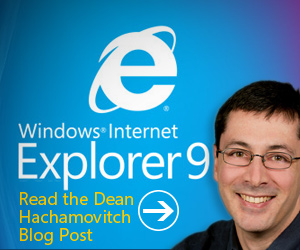REDMOND, Wash. — Dec. 7, 2010 — Recently, policy makers in Washington, D.C., Brussels, and around the world have discussed how companies collect, use and store information from people browsing online. With the development of Internet Explorer 9, Microsoft is introducing a new feature, “Tracking Protection,” to help consumers be in control of potential online tracking as they move around the Web.
Microsoft News Center spoke with Corporate Vice President Dean Hachamovitch, head of Internet Explorer development, and Chief Privacy Strategist Peter Cullen to learn more about the company’s privacy efforts with Internet Explorer 9 and what it means for consumers and the advertising industry.
News Center: How do you think about the intersection between the browser and privacy?
Cullen: Some consumers today have been very clear that they have privacy concerns, like being unclear about what information is being shared and how it is used as they browse. Some sharing is good – you may want a shopping site to know your history – but it is hard for anyone to differentiate today. The consumer challenge here is that the technologies involved are very complex and even the definitions – what exactly constitutes tracking – are still under development by the industry.

Consumers understand that they have a relationship with the site they visit directly, whose address is clearly visible to them. The modern Web though means that websites include content from many other sites as well. These “third-party” sites are in position to potentially track consumers, via cookies and other technology mechanisms. This creates a potential trade-off for those consumers with privacy concerns.
News Center: How is IE9 planning to address this intersection?
Hachamovitch: Our job in developing the next version of IE9 is to find the right balance between the real consumer benefits that can come from sharing, while providing the user choice and control with respects to their privacy. Internet Explorer 9 will include a new feature – Tracking Protection – to help consumers exercise that choice and control over their information online.
News Center: How is this new feature different than what users can do today?
Hachamovitch: Tracking Protection in IE9 puts people in control of what data is being shared as they move around the Web. It does this by enabling consumers to indicate what websites they’d prefer to not exchange information with. Consumers do this by adding Tracking Protection Lists to Internet Explorer. Anyone, and any organization, on the Web can author and publish Tracking Protection Lists. Consumers can install more than one. By default, there are no lists included in IE9, which is consistent with our previous IE releases with respect to privacy.
These lists include Web addresses for IE to treat as “Do Not Call” unless the consumer visits the address directly. The lists also include “OK to Call” addresses to make sure that the user can get to these addresses even if one of their lists has it as “Do Not Call.” Once the consumer has turned on Tracking Protection, it remains on until the person turns it off. Again, it’s worth noting that consumers have to turn on Tracking Protection and that by default IE9’s privacy protections are similar to IE8’s.
The short video below provides a good overview of how the feature works.
Tracking Protection complements the strong set of privacy features already in IE8, like InPrivate Browsing. InPrivate Browsing helps you control what your machine remembers about your browsing. It’s a good way to keep someone from seeing your browsing history “over your shoulder.” InPrivate Filtering was a forerunner of Tracking Protection.
News Center: Can you talk a little bit more about how information gets tracked online and how this will change with Tracking Protection?
Cullen: For example, say I visit a news site, then a sports site, and then some other website. Because the addresses and companies are completely different, you might expect that my activity on each of these sites is visible only to me and each of these sites.
Actually, it’s possible that many of these unrelated sites include content from the same third-party sites – sites I may have never heard of or know that I’m visiting. That content might look like a stock chart or weather report for my location, or it might also be invisible, like a cookie or script.

These third-party sites are in position to provide useful syndicated content across the web. They’re also in position, potentially, to build up a profile of browsing activity. There are a lot of benefits to this – for example, the content I see across pages and websites can be more relevant and personalized. At the same time, some people have expressed concern because they want more information, choice, and control about how their browsing data is being collected, shared and used.
If a consumer chooses to add a Tracking Protection List, Internet Explorer 9 prevents information from being sent to the addresses in that list. That prevents these third-party sites from getting some of consumer’s information, whether the sites uses cookies or another technology.
The actual results will vary depending on what sites the consumer visits (and how they’re built) and what Tracking Protection Lists the consumer adds to IE.
Because anyone can create a Tracking Protection List, we expect consumers to have a great deal of choice to match their comfort levels with sharing their data online.
News Center: Will you work with groups from the privacy space and with advertisers on these lists?
Hachamovitch: Yes. We’re excited to support all the organizations interested in developing these lists. As I said, equally important to “Do Not Call” lists are the “OK to Call” lists as a means to grow consumer trust.
Reaching out to the community early and often is an important pattern in product development, especially software. You can see this in action with Internet Explorer 9 and the many platform previews and beta that we’ve shared. The key thing is making information like this about the product available when it is relevant and actionable, and then listening to the feedback from the many, many different communities interested in the browser. That process has made the IE9 development process, and product, substantially better than previous releases. The discussions around hardware-accelerated HTML5 and same markup with the developer community, for example, have informed many changes to the product.
With all of the discussion both coming out of the FTC and elsewhere in the world about the role of browsers in the privacy space, we wanted to share our approach to protecting people from online tracking now so that the various stakeholders could provide feedback and could begin building lists before the feature ships in the release candidate of Internet Explorer 9.




